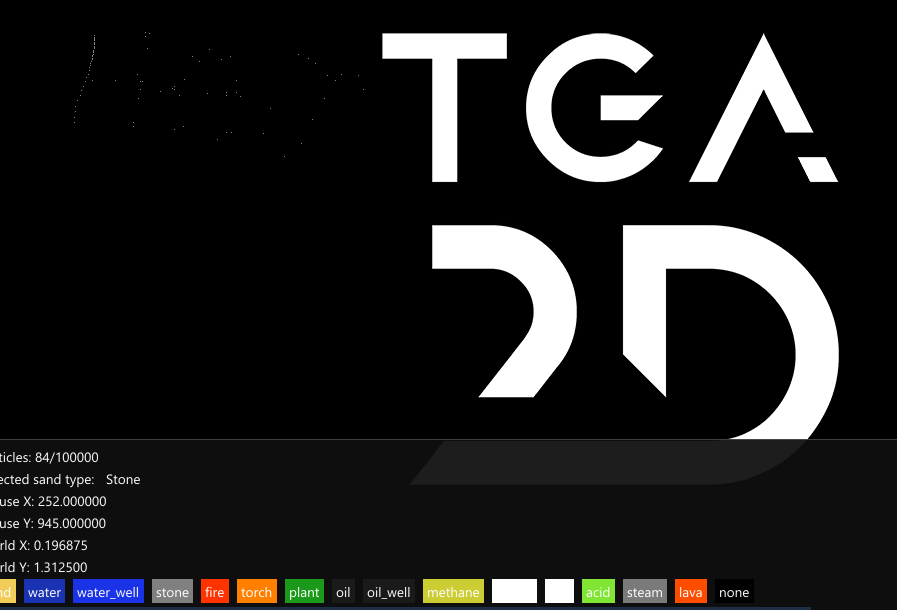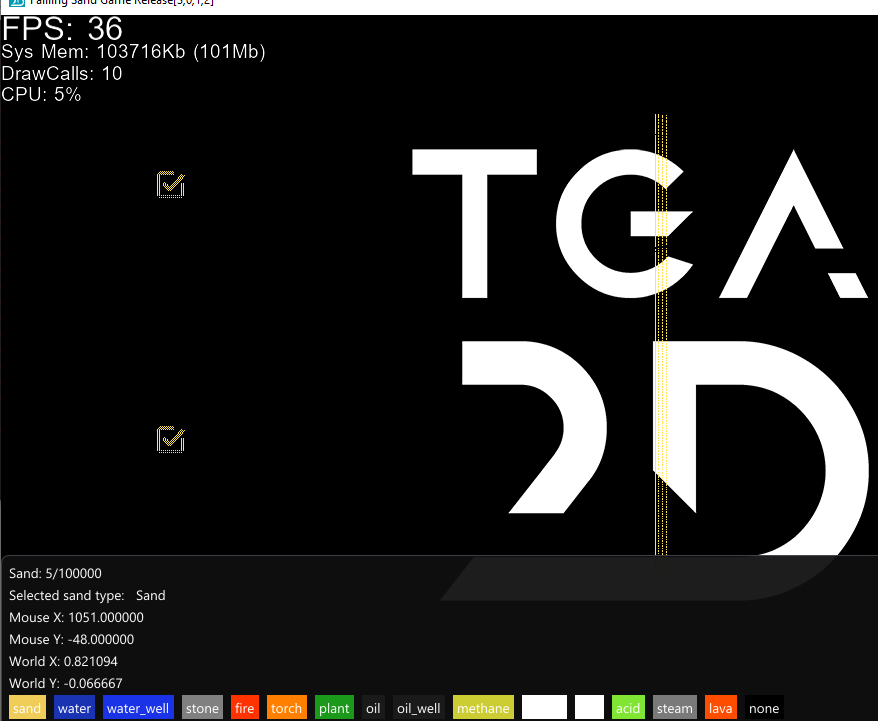School Specialization
Specialization Summation:
I tried making a falling sand game in TGA2D and it did not go as planned, but I worked around my problems to get a somewhat okay game in the end. I hope to improve on this as I have extra free time and make it better, in a better engine.
My Falling sand game
Falling sand game footage found on YouTube
During my specialization project:
I attempted to create a game akin to a Falling Sand game utilizing the TGA2D game engine, which can be found in the TGA2D forum. I meticulously arranged a sand world to govern all aspects, implemented a sand manager to oversee the entirety of the sand, and astutely employed IMGUI to gracefully handle all of the user interface components. For the rendering of the sand, I employed a sprite batch rendering technique. Seeking to optimize performance, I employed a Grid system and ingeniously threaded the sand manager to ameliorate its speed. The user interface, situated at the bottom of the screen, elegantly displays various elements. These include the current amount of sand gracing the world, the currently selected sand type, the precise position of the mouse, an assortment of buttons depicting the diverse sand types and their respective hues, a slider to modulate the brush size, and lastly, an innovative button to activate or deactivate the walls' "Collider" to ensure no particle of sand escapes the designated screen. To enable the efficient spawning of sand, I dutifully crafted a brush that caters to various brush sizes. Adding yet another element of marvel, I ingeniously devised an image-to-sand converter. This ingenious feature allows users to import an image into the game window either via a line of code or through a drag-and-drop action. Once the image is assimilated, the converter deftly converts each pixel to the nearest sand type and subsequently spawns it within the sand world. Yet, it must be acknowledged that during the course of my endeavor, a misstep occurred. After the conclusion of the second week, when I encountered difficulties with batch rendering, a more prudent approach would have entailed a reassessment and reconfiguration of my plan. However, beset by strain and duress, I persisted relentlessly in my attempts to overcome the rendering obstacle and consequently squandered valuable time. Reflecting upon this experience, were I afforded the opportunity to embark upon this venture anew, I would, given an abundance of time, construct a rudimentary engine myself or alternatively select a more comprehensively documented engine. The elegant rendering of the sand was executed by employing a miniature 1 by 1 image while simultaneously tracking the mouse's position and adroitly generating the corresponding sand particles.
Plan
- Week 1: Research Falling Sand Game, Download TGA2D, Set up Perforce, and get a base game working.
- Week 2: Add SandWorld, Sand, Sand Type, SandManager.
- Week 3: Add Grid/Chunks, Threading, ObjectPool.
- Week 4: 3 days Optimization, 1 day Debugging.
- Week 5: 4 days Polish/Debugging.
Each Thursday was debugging, and Friday I took a step back and adjusted the plan — this didn't always hold.
What Actually Happened
- Week 1: Research Falling Sand Game, Download TGA2D, Set up Perforce, and get a base game working.
- Week 2: Add SandWorld, Sand, Sand Type, SandManager.
- Week 3: Add SpriteBatch, Threading, ObjectPool. Had problems with batch rendering.
- Week 4: 1 day Optimization, 3 days Debugging. Progress on batch rendering.
- Week 5: 2 days Polish, 2 days Debugging. Got batch rendering working but too late. Entered crisis management to save and show work.
Classes Created
- Sand.cpp — Collider, Sprite, Texture, Position, Velocity, Size, Acceleration, Density, Friction, Type, Name, ID, Gravity.
- SandManager.cpp — Tracks all sand: spawning, removing, manipulation.
- SandType.cpp — Sand parameters: Name, Tooltip, texturePath.
- SandWorld.cpp — Centralized game control.
- ObjectPool.hpp — Basic object pooling system.
- UI.cpp — All UI via IMGUI.
- Utilities.hpp — Drag and drop functions.
Sand Types
- Sand – sinks in water
- Water – eats salt
- Water Well – water source
- Stone – does not move
- Fire – burns stuff
- Torch – fire source
- Plant – grows if watered
- Oil – burns on contact with fire
- Oil Well – oil source
- Methane – steam but flammable
- Eraser – removes other sands
- Salt – dissolves in water
- Acid – eats most things, weakens itself
- Steam – when fire meets water
- Lava – mix of fire and stone



